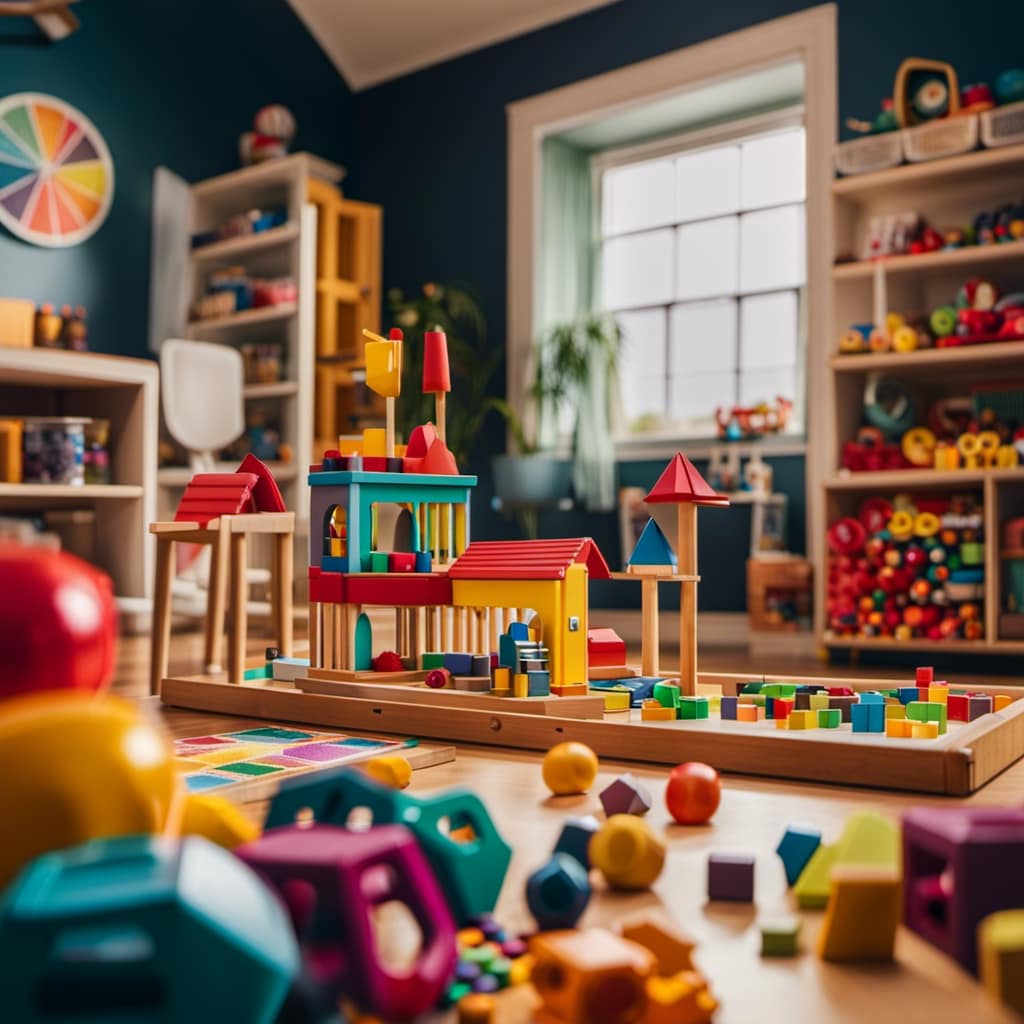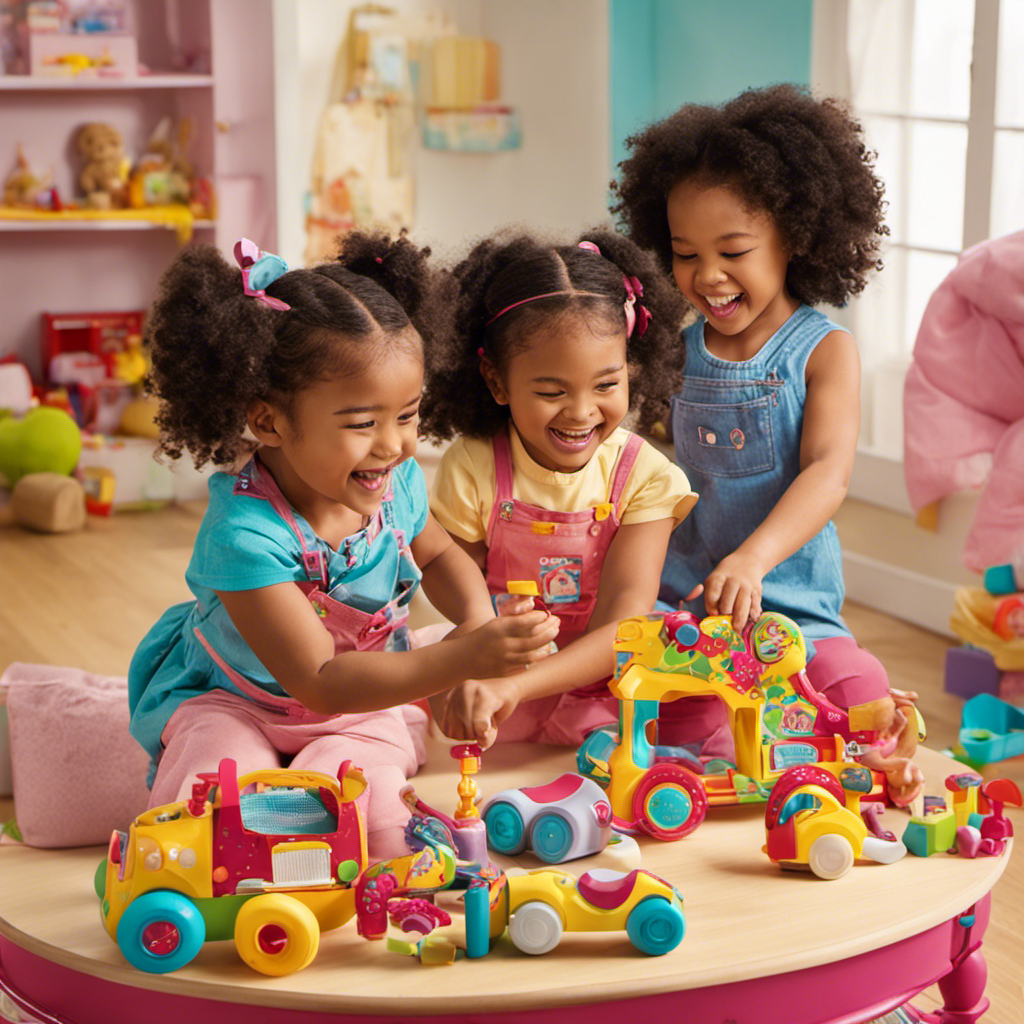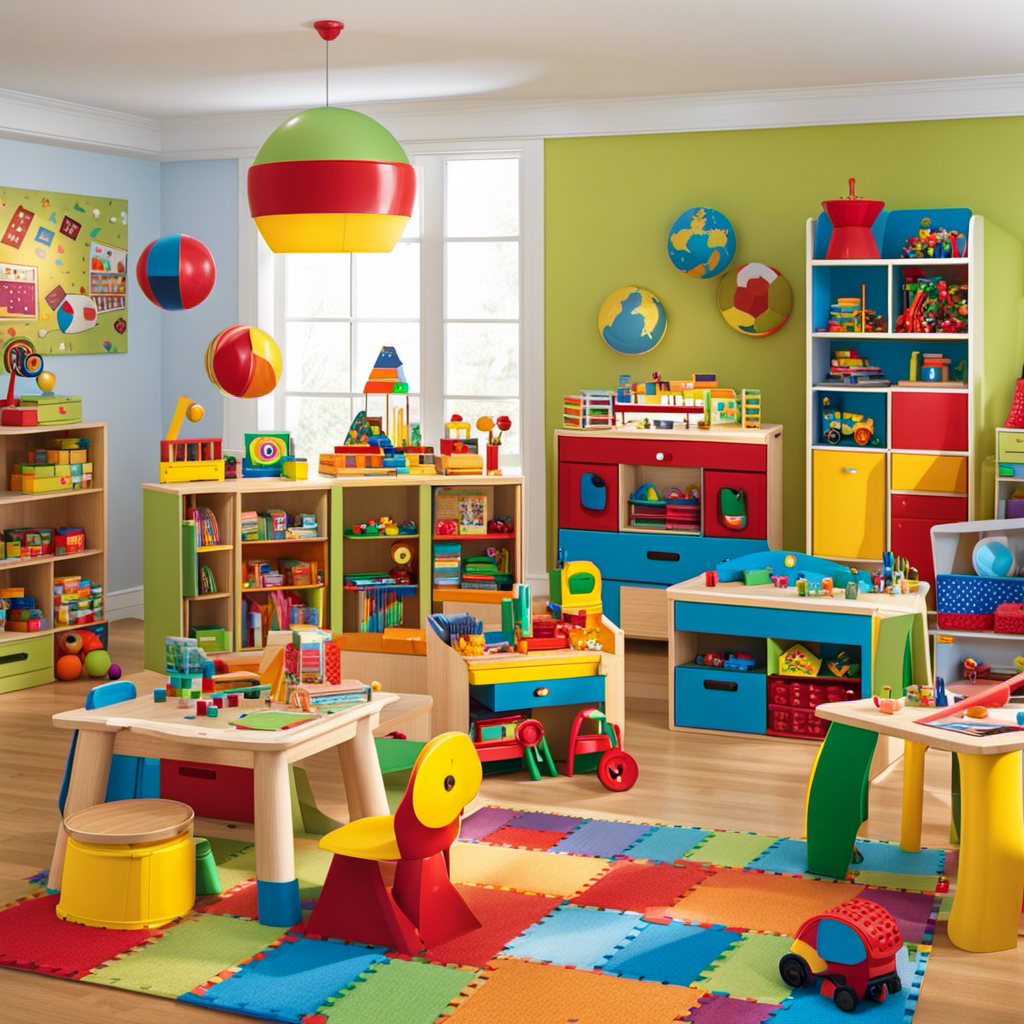We have the insider information on the top 15 sensory toys for preschoolers with autism! These toys act as mini assistants, both captivating and calming simultaneously.
From fidget spinners to sensory swing sets, they provide a world of sensory exploration.
With weighted blankets, sensory balls, and chewelry, these toys offer comfort and stimulation.
Let’s dive in and discover the perfect tools to support the sensory needs of children in their preschool journey.
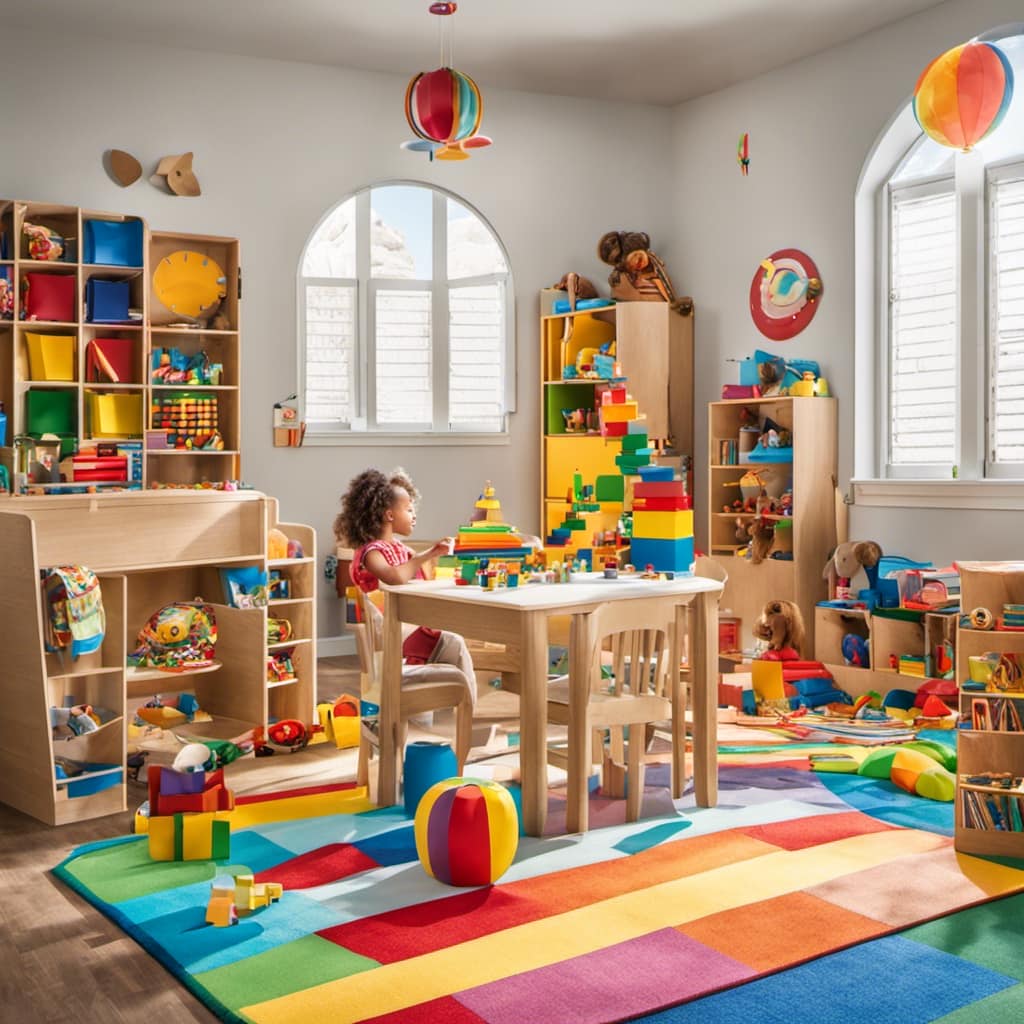
Key Takeaways
- Fidget Spinners are popular sensory toys for preschoolers with autism, providing calming and focusing effects through spinning motion.
- Weighted Blankets offer deep pressure stimulation, promoting calmness and reducing anxiety. It is important to consider body weight and sensory preferences when choosing.
- Sensory Balls are beneficial for sensory exploration, fine motor skill improvement, and stress relief.
- Chewelry is a wearable sensory tool for oral sensory needs, helping with self-regulation, anxiety reduction, and focus improvement. It is safe and durable for continuous use.
Fidget Spinners
Fidget spinners have become popular among preschoolers with autism for their calming and focusing effects. These handheld toys provide sensory benefits that can help children with autism manage their sensory needs.
Fidget spinners come in different types, each designed to cater to specific sensory needs. Some spinners have textured surfaces, providing tactile stimulation, while others have different colors and patterns, offering visual stimulation. There are also spinners with different weights, providing proprioceptive input and promoting a sense of grounding.
The spinning motion of the fidget spinner can help children with autism focus their attention and reduce anxiety. It can also serve as a tool for self-regulation, allowing children to redirect their energy in a controlled and productive manner.
Fidget spinners, with their various sensory benefits and types, have proven to be effective tools for preschoolers with autism.
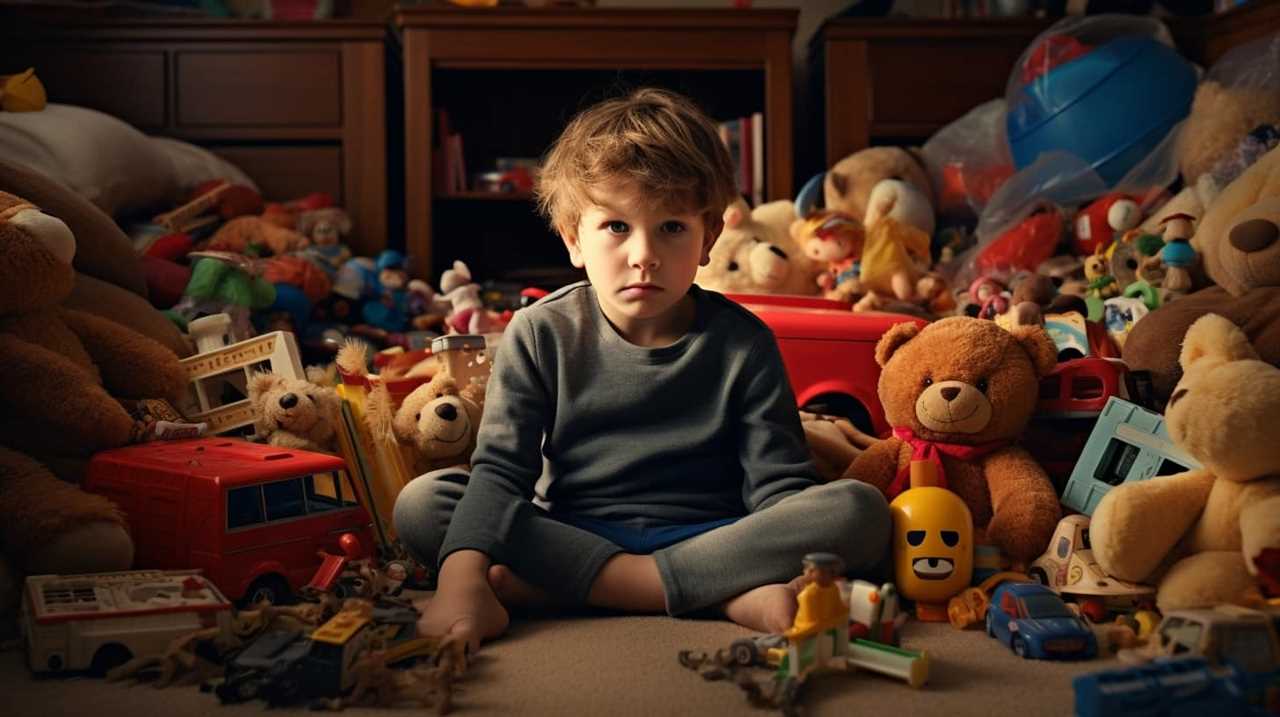
Weighted Blankets
Let’s talk about the sensory benefits of weighted blankets and how to choose the right weight for your child with autism.
Weighted blankets provide deep pressure stimulation, which can help calm and soothe individuals with sensory processing difficulties.
When selecting a weighted blanket, it’s important to consider the individual’s body weight and sensory preferences to ensure optimal therapeutic benefits.
Sensory Benefits of Weighted Blankets
One of the key benefits of using weighted blankets for children with autism in preschool is the calming and soothing effect they provide. These blankets are designed to simulate a deep pressure touch, which has been shown to reduce anxiety and promote relaxation in individuals with autism.
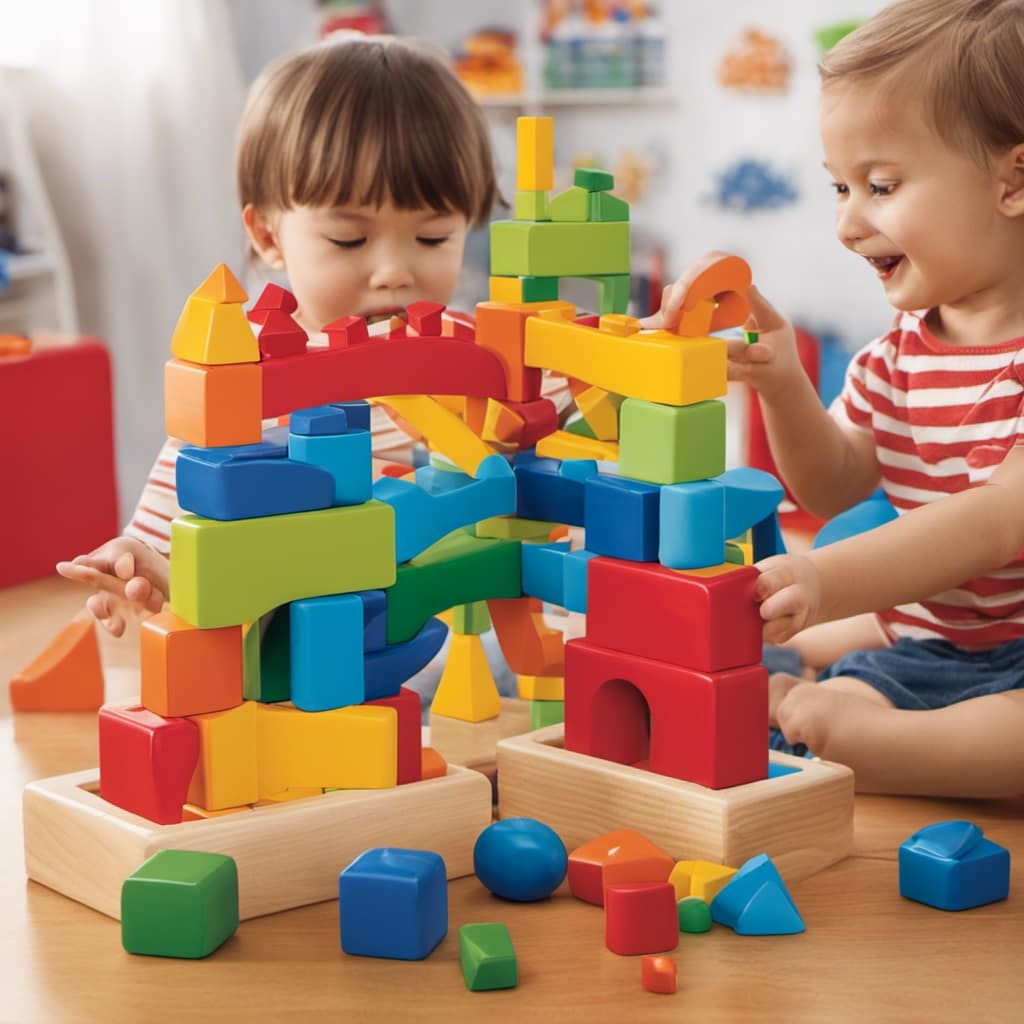
Here are three sensory benefits of weighted blankets:
-
Deep pressure stimulation: The added weight of the blanket provides a gentle, constant pressure that can help regulate the sensory system and promote a sense of calmness.
-
Improved sleep: Many children with autism struggle with sleep disturbances. The deep pressure provided by a weighted blanket can help regulate sleep patterns, leading to better quality and longer duration of sleep.
-
Reduced anxiety: Weighted blankets have been found to help alleviate symptoms of anxiety by providing a comforting and secure feeling. The deep pressure touch stimulates the release of serotonin, a neurotransmitter that contributes to feelings of happiness and relaxation.
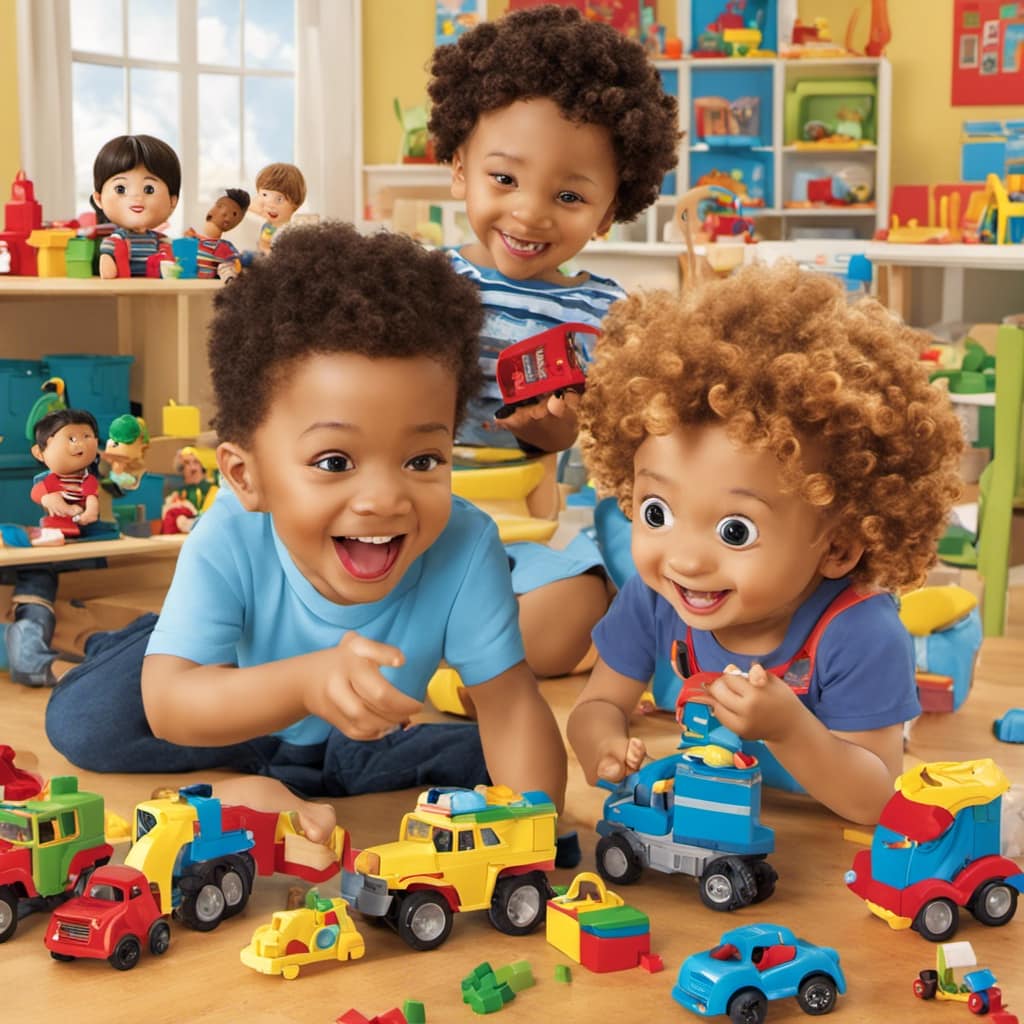
Choosing the Right Weight
When selecting a weighted blanket for a child with autism in preschool, we need to consider the appropriate weight to provide the most effective sensory benefits. The weight of the blanket should be chosen based on the individual needs and preferences of the child. Too light of a weight may not provide enough deep pressure stimulation, while a weight that is too heavy could be overwhelming and uncomfortable. It is recommended to choose a blanket that is around 10% of the child’s body weight. However, it is important to consult with a healthcare professional or occupational therapist to determine the best weight for your child. They can provide guidance and ensure the safety and effectiveness of the weighted blanket.
| Weight Range | Recommended Weight |
|---|---|
| 20-30 lbs | 2-3 lbs |
| 30-40 lbs | 3-4 lbs |
| 40-50 lbs | 4-5 lbs |
Sensory Balls
Let’s talk about sensory balls, one of the top sensory toys for children with autism in preschool.
There are different types of sensory balls available, such as textured balls, light-up balls, and squishy balls, each offering unique sensory experiences.
These balls provide various benefits, including promoting sensory exploration, improving fine motor skills, and relieving stress and anxiety.

We’ll also discuss how to effectively use sensory balls to engage and support children with autism in their sensory development.
Types of Sensory Balls
We love using different types of sensory balls in our preschool to engage and stimulate the senses of children with autism. Sensory balls offer a variety of textures, sizes, and colors, providing a rich sensory experience for children.
Here are three types of sensory balls that we find particularly beneficial:
-
Bumpy Balls: These balls have small bumps or ridges on the surface, which provide tactile stimulation and enhance sensory exploration. Children can roll them, squeeze them, or even use them for massage.
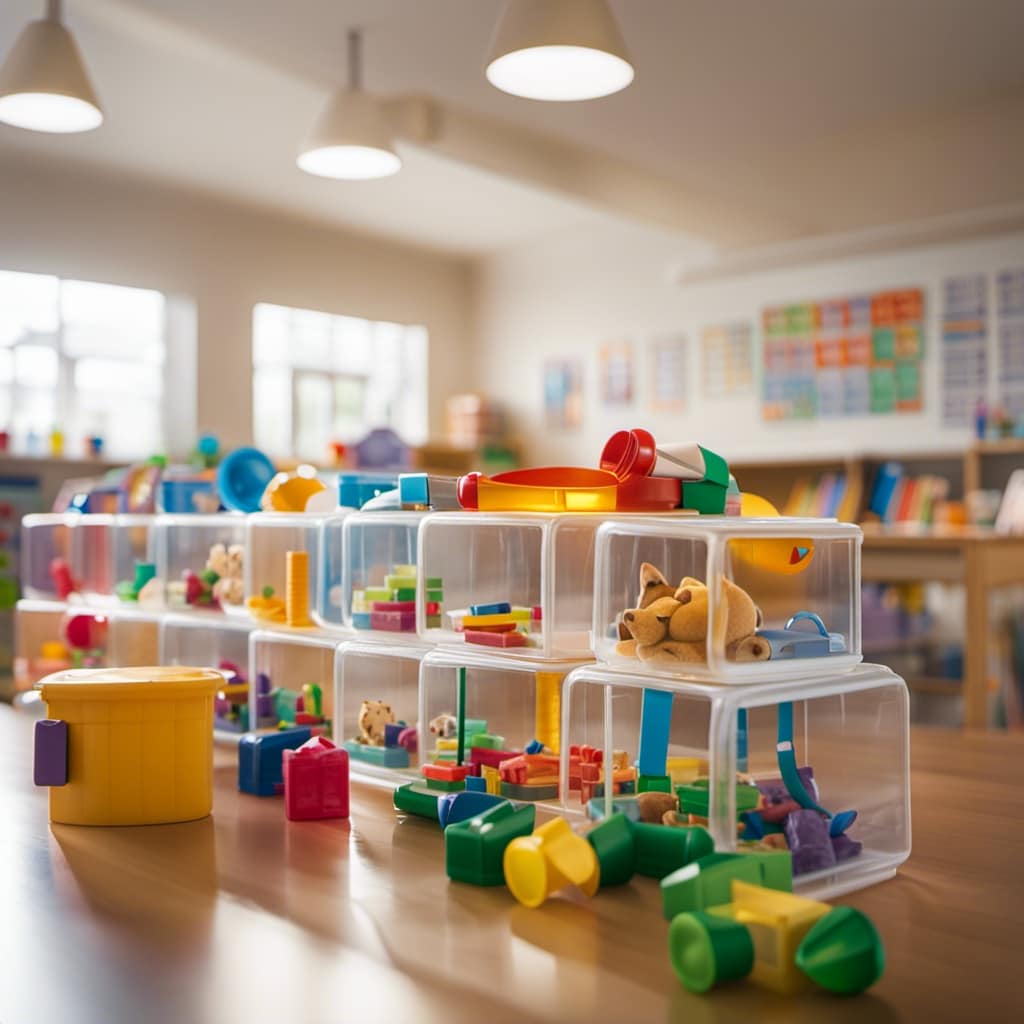
-
Light-Up Balls: These balls contain LED lights that flash or change colors when squeezed or bounced. They help to develop visual tracking skills and can be particularly engaging for children with visual sensory preferences.
-
Textured Balls: These balls have different textures, such as spikes, nubs, or grooves, which offer tactile input and promote sensory exploration. Children can feel the different textures with their hands or feet, enhancing their sensory awareness.
Benefits of Sensory Balls
Using sensory balls in our preschool provides numerous benefits for children with autism. Sensory balls aren’t only fun and engaging, but they also serve as a valuable tool for sensory integration and regulation.
For children with ADHD, sensory balls can help improve focus and attention by providing a tactile and proprioceptive input. These balls offer a wide range of sensory experiences, such as different textures, sizes, and shapes, which can enhance sensory exploration and promote sensory processing skills.
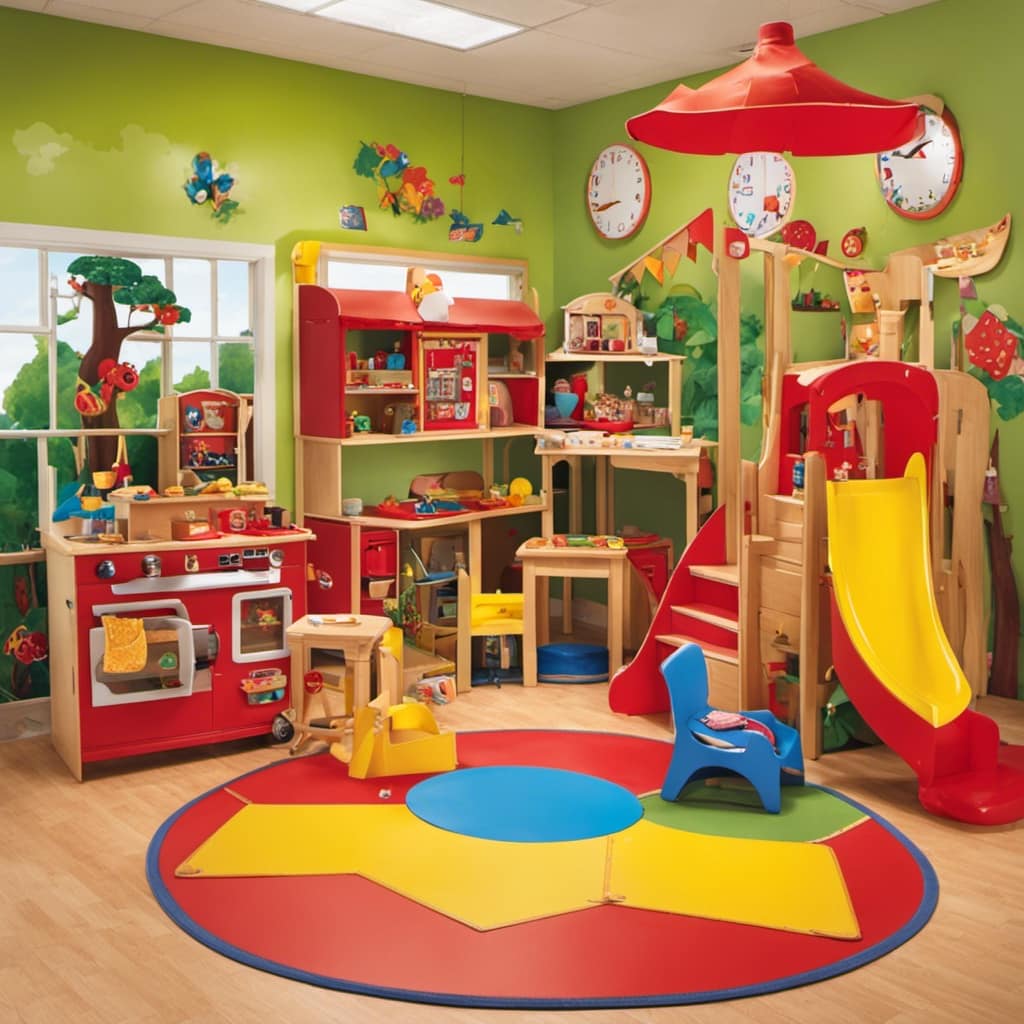
Additionally, sensory ball exercises can help develop motor skills, coordination, and balance. They provide a safe and controlled environment for children to practice their gross motor skills, such as throwing, catching, and kicking.
Overall, incorporating sensory balls into our preschool activities can have a positive impact on the sensory, motor, and attention needs of children with autism.
Now, let’s explore how to use them effectively.
How to Use Them
How can we effectively utilize sensory balls in our preschool activities for children with autism?

Here are three ways to incorporate sensory balls into your sensory play activities:
-
Sensory exploration: Encourage children to touch, squeeze, and roll the sensory balls. This tactile experience helps develop their fine motor skills and provides a calming effect.
-
Gross motor skills: Use the sensory balls for activities that promote movement, such as rolling the ball back and forth or playing catch. These activities enhance coordination, balance, and body awareness.
-
Sensory integration: Incorporate sensory balls into sensory bins or ball pits, creating a stimulating environment for children to explore. This helps them regulate their sensory input and improve their ability to process sensory information.
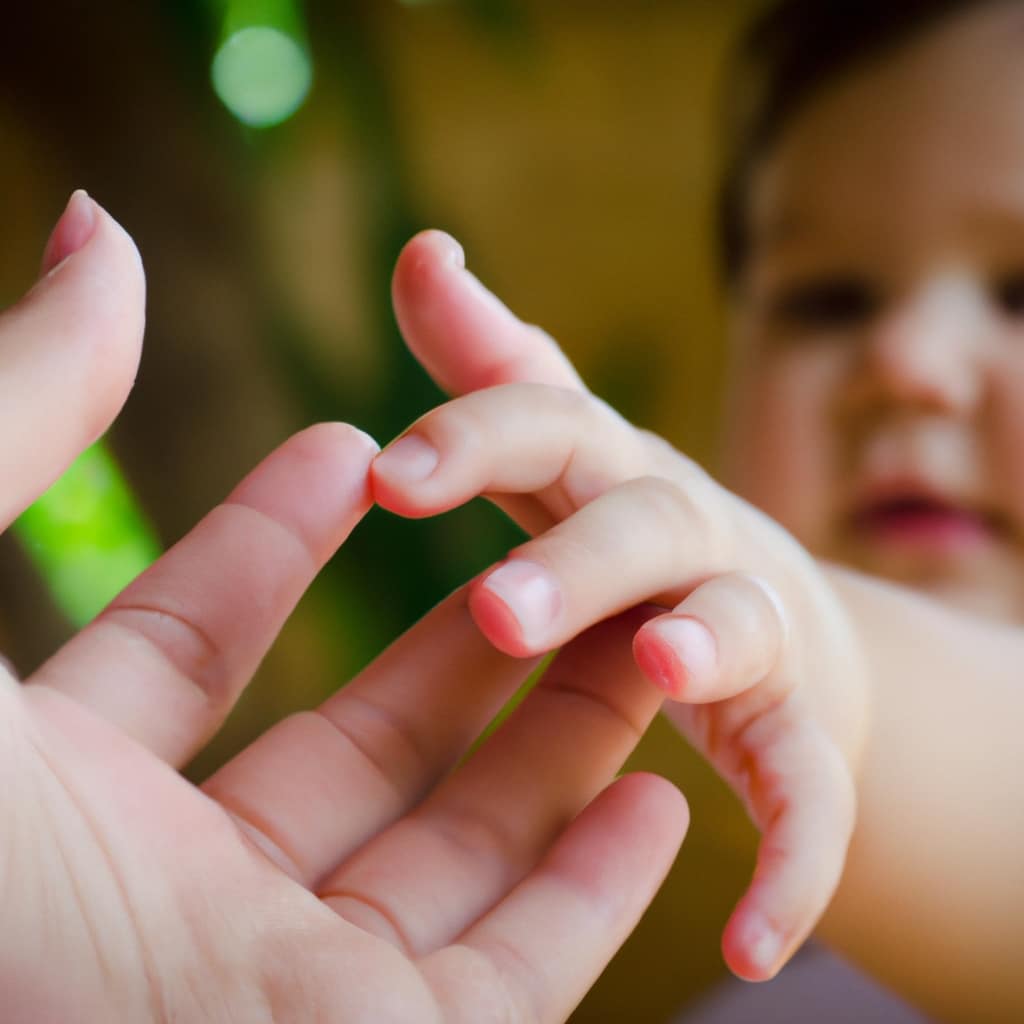
Chewelry
One popular sensory toy for autism in preschool is chewable jewelry. Chewelry, as it’s commonly known, refers to accessories that are safe for children to chew on. These toys offer a range of benefits for children with autism, including providing oral sensory stimulation, promoting self-regulation, and reducing anxiety.
Chewelry comes in various options, such as necklaces, bracelets, and pencil toppers. They’re designed to be durable, non-toxic, and easily cleaned. By providing a safe and appropriate outlet for chewing, chewelry helps children satisfy their oral sensory needs and can prevent them from chewing on unsafe objects.
It’s important to choose the right chewelry option for each child, taking into consideration their individual preferences and sensory needs.
Sensory Bottles
We found that sensory bottles are another effective sensory toy for autism in preschool. Sensory bottles are clear plastic bottles filled with various materials that provide visual and tactile stimulation. They can be easily customized to meet the specific sensory needs of each child.

Here are three examples of calming sensory activities that sensory bottles can offer:
-
Floating Glitter Bottle: Fill a bottle with water, clear glue, and glitter. As the glitter settles, it creates a mesmerizing visual display that can help children relax and focus.
-
Ocean in a Bottle: Fill a bottle with water, blue food coloring, and small sea-themed objects like shells or plastic fish. Children can shake the bottle and watch as the objects float and move in the water, creating a calming and soothing effect.
-
Rainbow Sensory Bottle: Fill a bottle with water, clear glue, and colored beads or sequins. As children tilt and turn the bottle, the beads and sequins create a beautiful, colorful show that engages their visual senses.
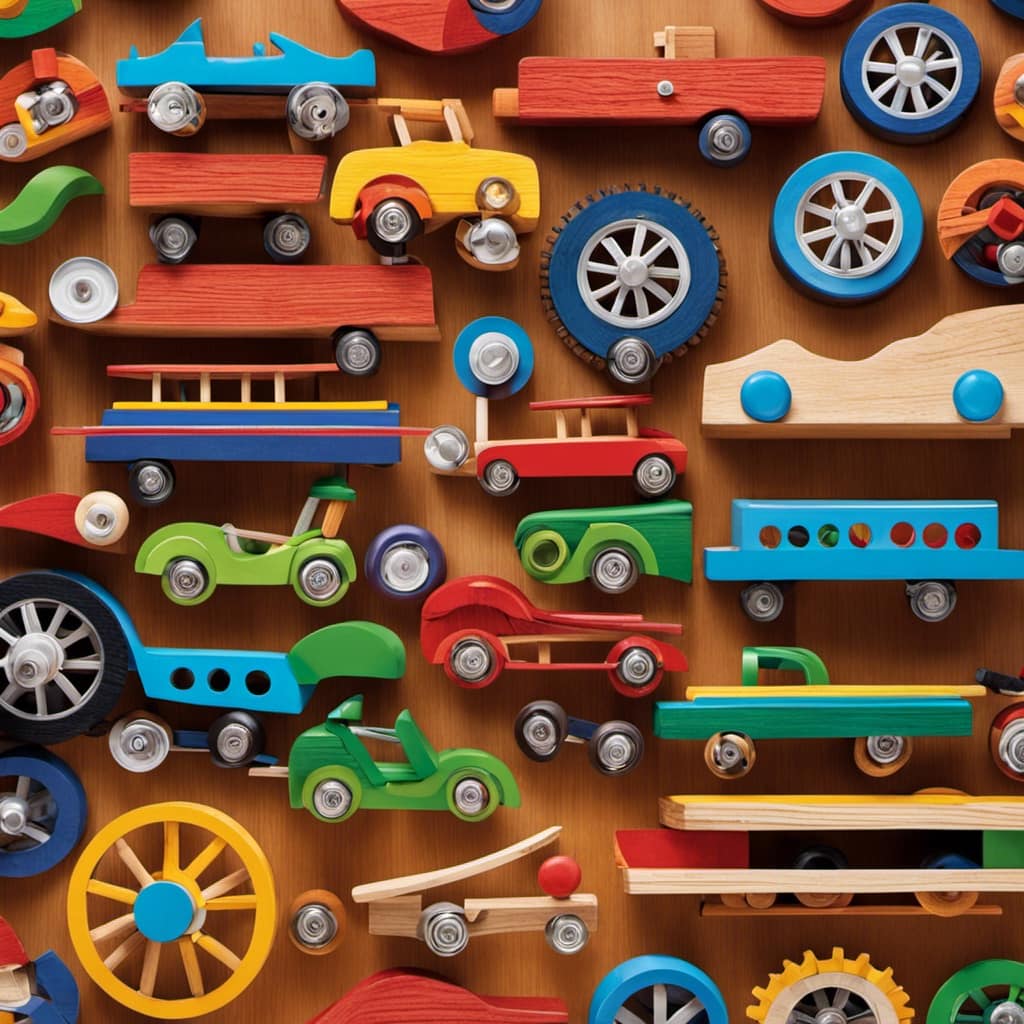
Sensory bottles provide a safe and engaging way for children with autism to explore and regulate their senses.
Tactile Sensory Mats
The tactile sensory mats are a versatile and interactive sensory toy for autism in preschool. These mats provide a fun and engaging way for children with autism to explore different textures and sensations.
The mats are made of soft, durable materials that are safe for children to touch and play with. They come in various shapes, sizes, and designs, allowing for endless possibilities of sensory exploration.
Children can use their hands, feet, or even their whole body to experience the different textures and sensations that the mats offer. The tactile sensory mats can be used in therapy sessions or as part of a sensory play area in the classroom.
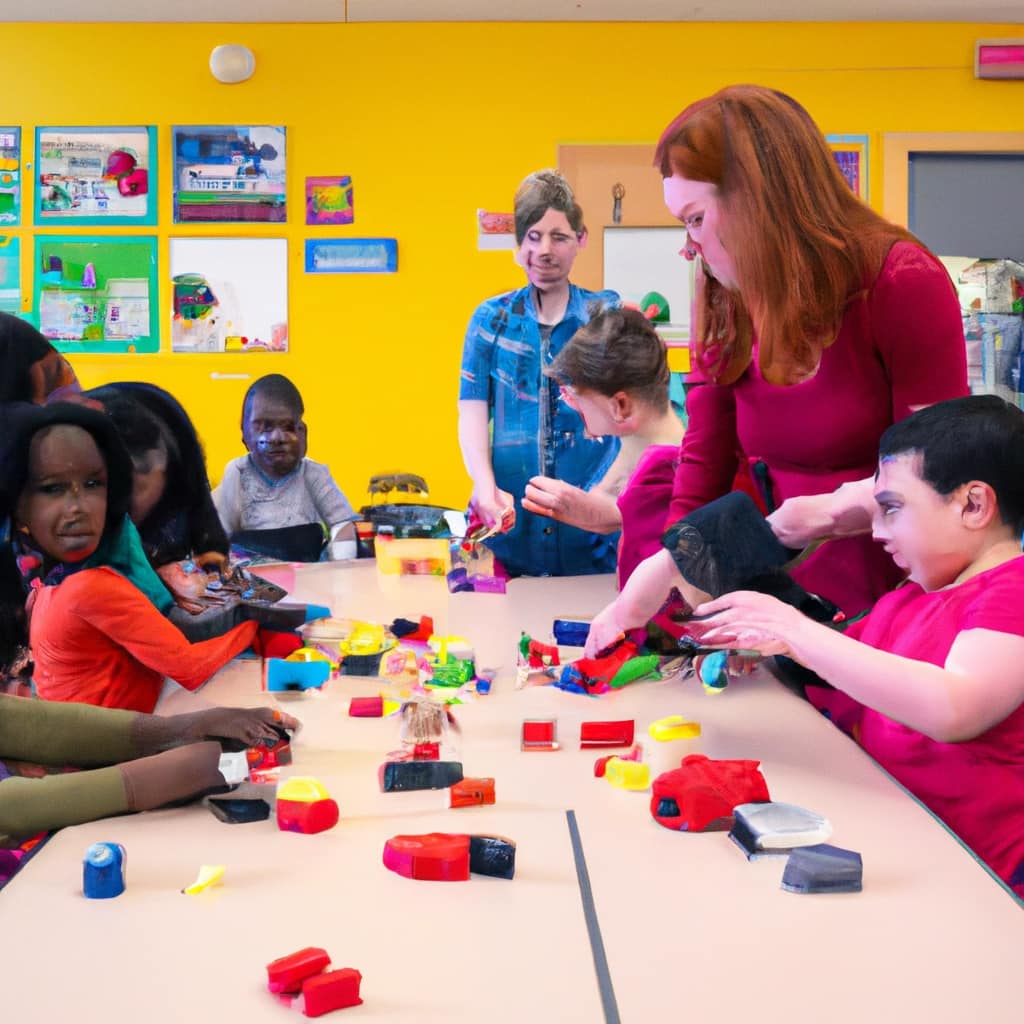
They can also be combined with other sensory toys like sensory playdough or sensory swing sets to create a multi-sensory experience for children with autism. These mats provide a safe and stimulating environment for children to learn and develop their sensory skills.
Therapy Putty
Continuing with our exploration of sensory toys for autism in preschool, let’s now delve into the benefits of therapy putty.
Therapy putty is a versatile tool that offers a range of benefits for children with autism. Here are three key advantages of using therapy putty:
-
Sensory Stimulation: Therapy putty provides tactile input, helping children develop their sense of touch. It offers a unique sensory experience, allowing them to explore different textures, temperatures, and resistances.

-
Fine Motor Skills Development: Manipulating therapy putty strengthens hand muscles and improves dexterity. Children can pinch, squeeze, and mold the putty, enhancing their fine motor skills and hand-eye coordination.
-
Stress Relief: Therapy putty can be a calming tool for children with autism. The repetitive motions and tactile feedback can help reduce anxiety and promote relaxation.
There are various types of therapy putty available, including scented, glow-in-the-dark, and color-changing options. Each type offers a distinct sensory experience, providing children with engaging and therapeutic play opportunities.
Sensory Brushes
Let’s talk about sensory brushes and how they can provide sensory stimulation for children with autism in preschool.

Sensory brushes have many benefits, such as promoting relaxation, improving focus, and reducing sensory sensitivities.
When choosing a sensory brush, it’s important to consider factors like the bristle type, size, and texture to find the right one that suits your child’s needs.
Brushing for Sensory Stimulation
How can we effectively use sensory brushes for sensory stimulation in preschoolers with autism? Sensory brushes are a valuable tool for providing tactile input and promoting sensory stimulation in children with autism. Here are three techniques to effectively use sensory brushes:
-
Deep Pressure Brushing: Apply firm, even pressure using the sensory brush in long, sweeping motions. This can help calm and regulate the child’s sensory system.
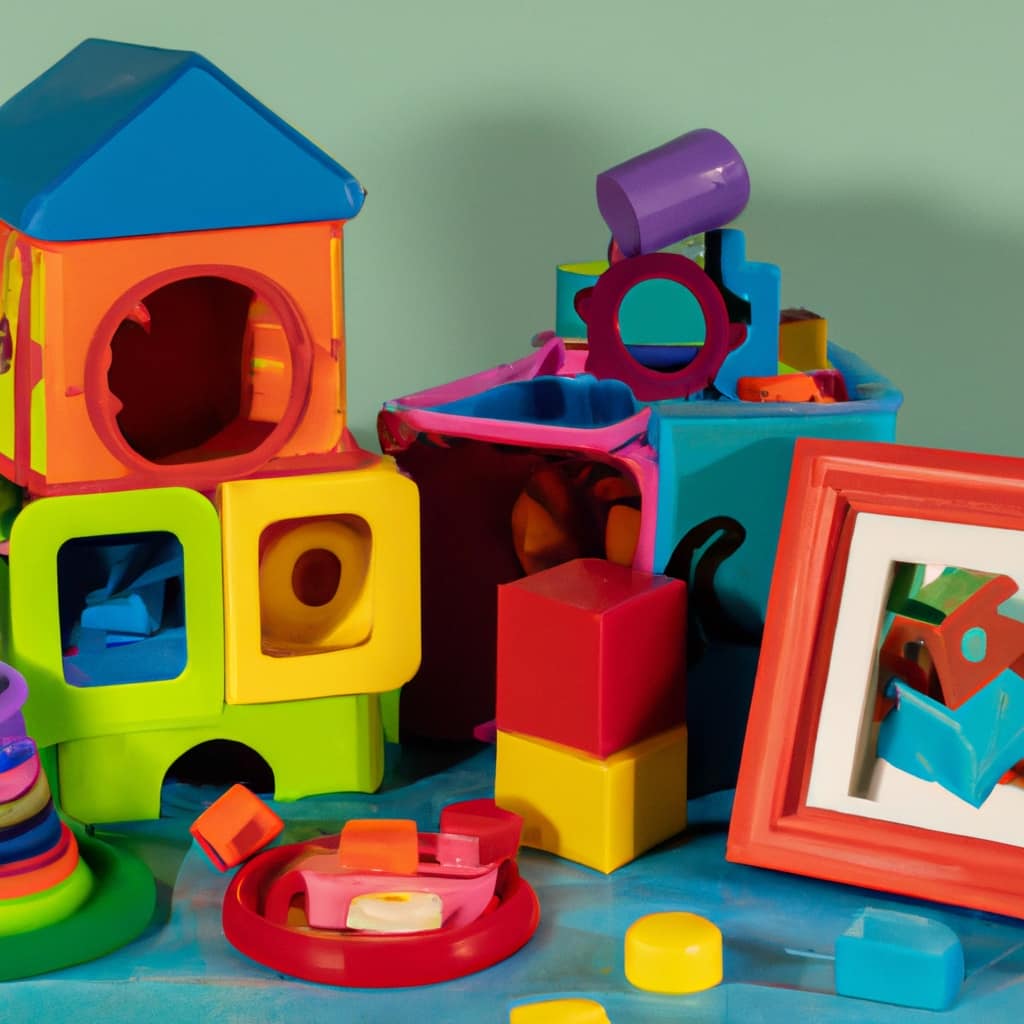
-
Joint Compression Brushing: Use the sensory brush to apply gentle pressure to the child’s joints, such as their elbows and knees. This can provide proprioceptive input and improve body awareness.
-
Scalp Brushing: Gently brush the child’s scalp using the sensory brush. This can provide a soothing sensation and promote relaxation.
Benefits of Sensory Brushes
Sensory brushes offer numerous benefits for preschoolers with autism, enhancing their sensory experiences and promoting sensory stimulation. These brushes are designed to provide therapeutic input through brushing techniques that help with sensory integration.
One of the key benefits of sensory brushes is their ability to provide deep pressure input, which can have a calming effect on children with autism. The brushing motion also helps to increase body awareness and improve sensory processing. By engaging the sensory system, these brushes can assist in regulating sensory input, reducing sensory overload, and promoting self-regulation.
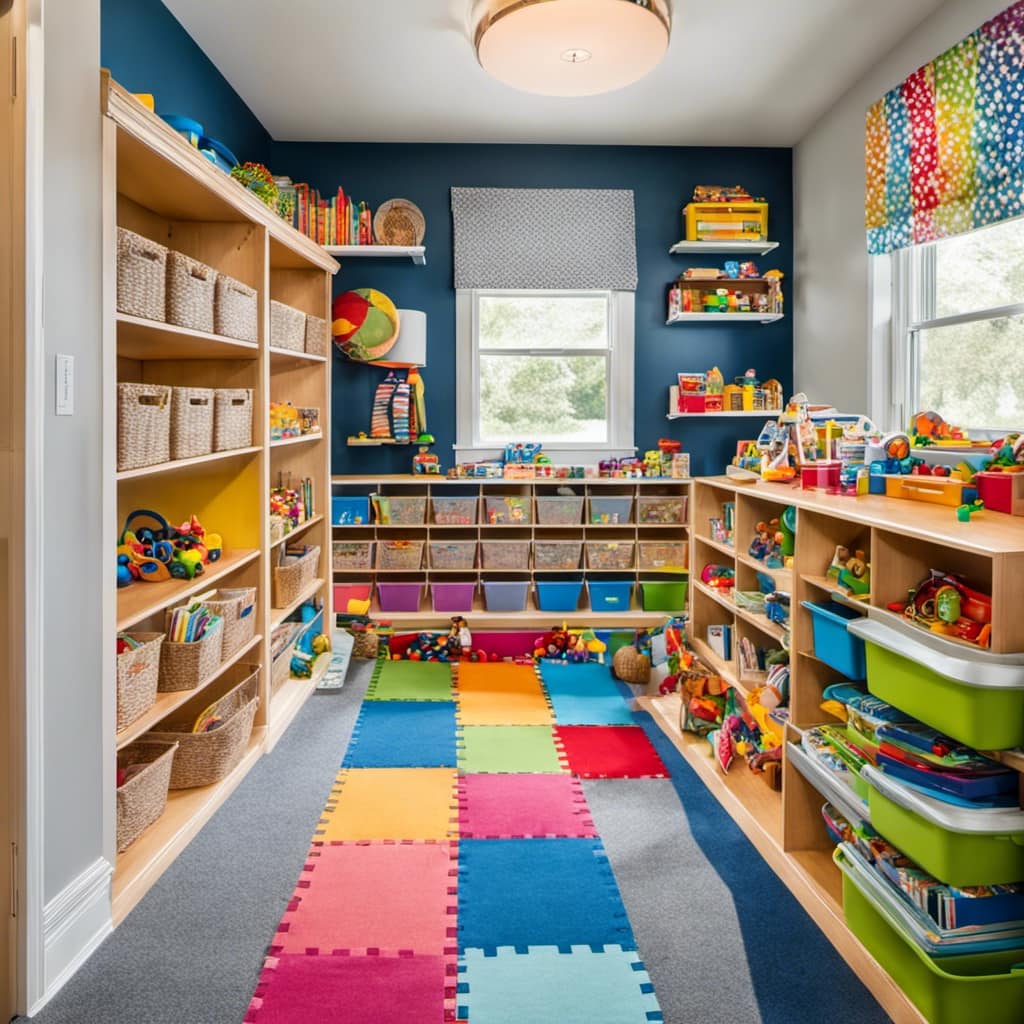
Additionally, sensory brushes can improve fine motor skills and tactile discrimination, as well as enhance attention and focus. Incorporating sensory brushes into a preschooler’s routine can be a valuable tool in supporting their sensory needs and overall development.
Choosing the Right Brush
One important step in selecting the right brush for sensory play is considering the specific needs and preferences of preschoolers with autism. When choosing the right brush, it’s important to consider the bristle texture that will provide the most comfort and stimulation for the child. Here are three options to consider:
-
Soft bristles: These brushes provide a gentle and soothing sensory experience for children who are sensitive to touch. The soft bristles can help calm and relax the child, promoting a sense of comfort and security.
-
Firm bristles: For children who crave more intense sensory input, brushes with firm bristles can provide the right amount of stimulation. These brushes can be used to provide deep pressure and proprioceptive input, helping the child regulate their sensory system.
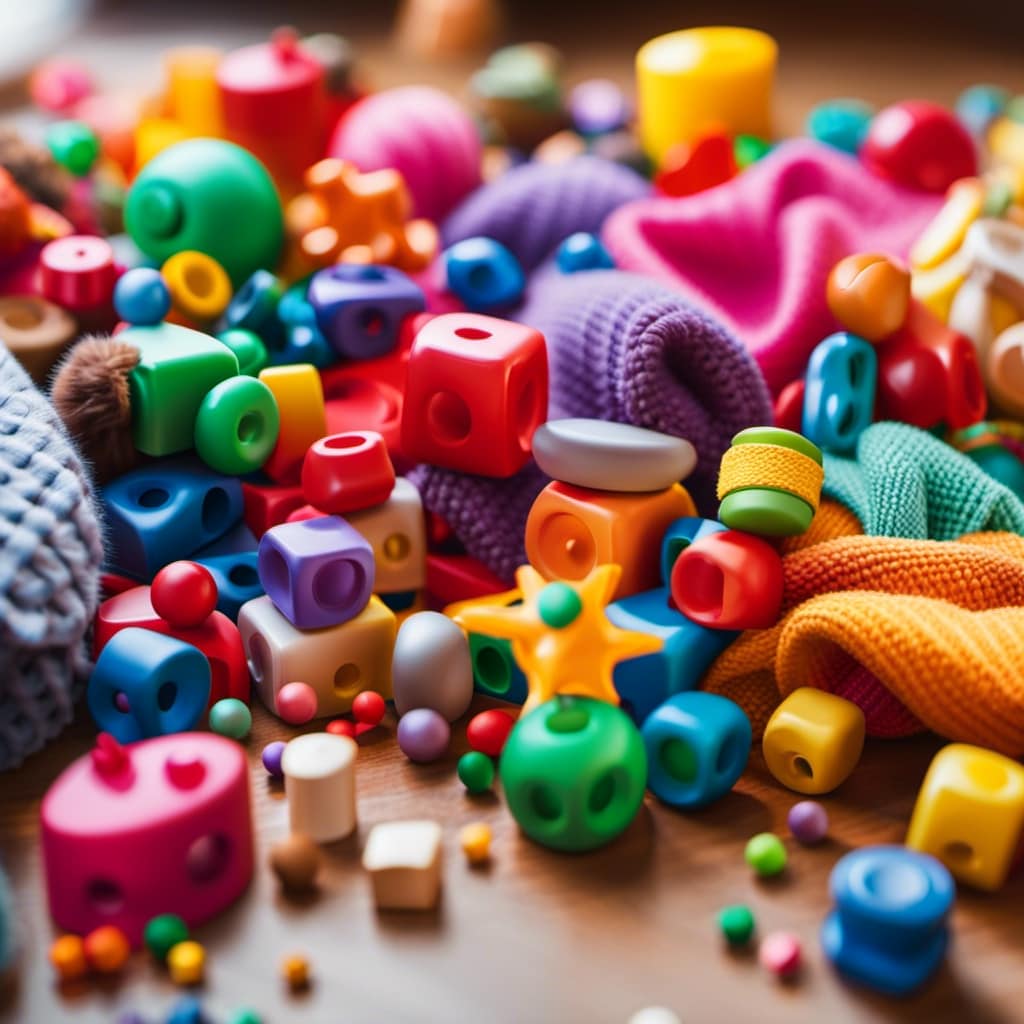
-
Silicone bristles: Silicone bristles offer a unique sensory experience, as they’re flexible and provide a different texture compared to traditional bristles. They can be especially beneficial for children who’ve oral sensory needs or enjoy tactile exploration.
Choosing the right bristle texture can make a significant difference in the effectiveness of sensory brushing for children with autism. Sensory brushing has numerous benefits, including promoting relaxation, improving body awareness, and enhancing sensory integration. By selecting the appropriate brush, you can provide the ideal sensory experience for your child’s unique needs and preferences.
Now, let’s move on to discussing another beneficial sensory toy for preschoolers with autism: squeezy stress balls.
Squeezy Stress Balls
We found that using squeezy stress balls in our preschool classroom has been highly beneficial for children with autism. These stress balls provide a safe and effective way for children to release their anxiety and promote a sense of calmness. They are a great alternative to traditional sensory toys and offer unique benefits for anxiety relief.

Here is a table showcasing the benefits of using squeezy stress balls:
| Benefits | Description |
|---|---|
| Anxiety Relief | Squeezy stress balls provide a tactile and sensory experience that helps alleviate anxiety. |
| Calming Effect | The act of squeezing the stress ball can have a soothing effect, promoting relaxation. |
| Fidgeting Solution | Stress balls offer a healthy outlet for fidgeting, helping children focus and concentrate. |
Sensory Playdough
Moving on to the next sensory toy in our preschool classroom, let’s explore the benefits of incorporating sensory playdough for children with autism.
Sensory playdough provides a multitude of sensory experiences that can be both calming and engaging for children on the autism spectrum. Here are three reasons why sensory playdough can be beneficial:
-
Tactile Stimulation: The squishy texture of playdough allows children to engage their sense of touch, promoting sensory exploration and fine motor skill development.
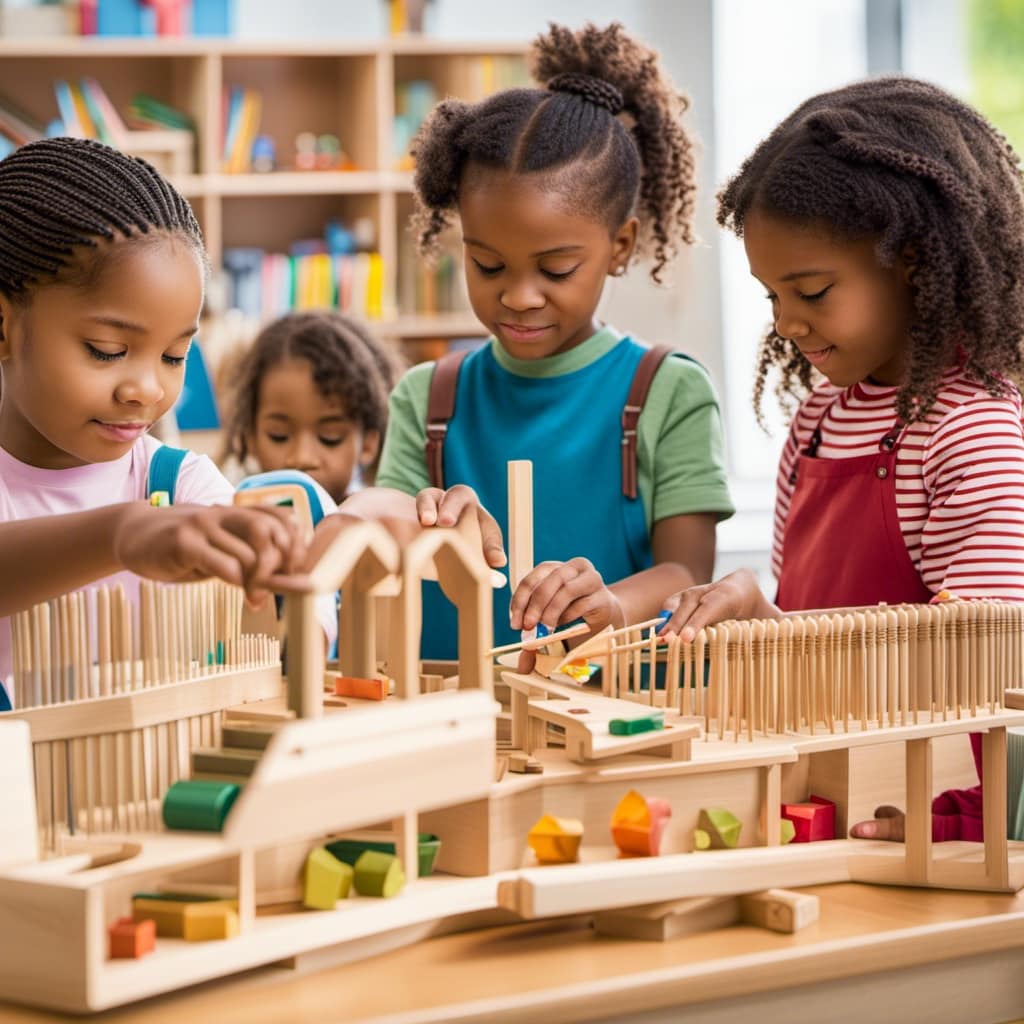
-
Scented Sensations: Adding scents to the playdough, such as lavender or citrus, can create a calming and soothing experience for children. The different scents can also stimulate their sense of smell, adding another layer of sensory input.
-
Creativity and Expression: Playdough provides a medium for children to express their creativity and imagination. They can mold and shape the playdough into various forms, encouraging self-expression and cognitive development.
Incorporating sensory playdough into the classroom can provide a fun and therapeutic experience for children with autism, allowing them to engage their senses and explore their creativity.
Visual Sensory Toys
Visual sensory toys are an essential tool for children with autism in preschool. These toys provide colorful visual stimulation, helping to engage and captivate their attention.

Colorful Visual Stimulation
Colorful visual stimulation engages and captivates children with autism in preschool. It provides a sensory experience that can be both calming and stimulating. Here are three colorful sensory toys that offer visual stimulation techniques:
-
Fiber Optic Lamp: This mesmerizing lamp features strands of colorful lights that change and twinkle, creating a calming visual display. Children can touch and interact with the soft fibers, enhancing their tactile and visual senses.
-
Light-up Bubble Tube: This sensory toy creates a captivating visual experience with its vibrant, bubbling colors. As the bubbles rise, children can watch the changing lights and feel a sense of calm and relaxation.
-
Projection Night Light: This toy projects colorful images, shapes, and patterns onto the walls or ceiling, creating a visually stimulating environment. It encourages imagination and can serve as a soothing bedtime routine.
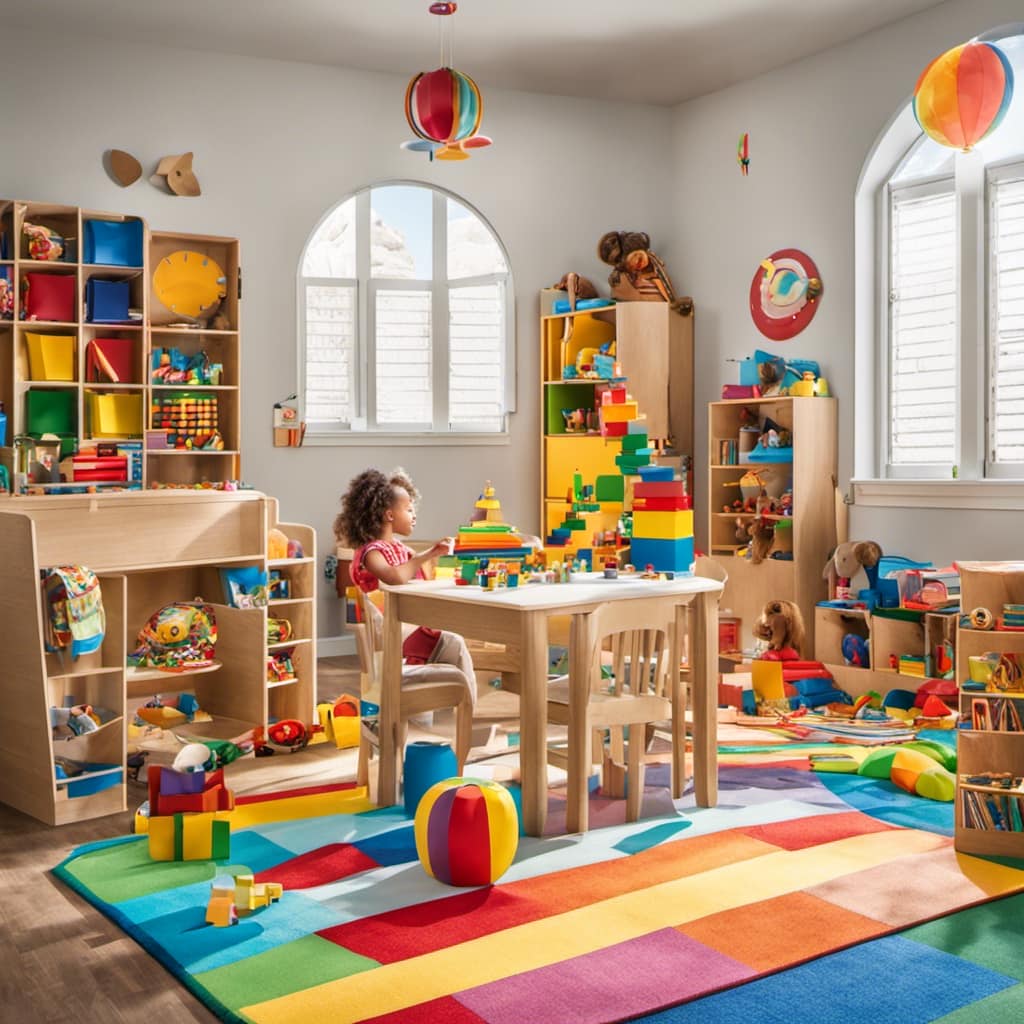
These colorful visual stimulation toys provide a sensory-rich experience that can enhance the development and engagement of children with autism in preschool.
Enhancing Visual Perception
As we continue exploring sensory toys for children with autism in preschool, let’s now delve into the topic of enhancing visual perception through the use of visual sensory toys. Visual perception plays a crucial role in a child’s development, and these toys can provide valuable opportunities for sensory engagement and learning.
One effective way to enhance visual perception is through sensory puzzles. These puzzles are designed to stimulate the child’s visual senses while engaging their problem-solving skills. By manipulating the puzzle pieces and observing how they fit together, children can improve their visual processing and spatial awareness.
Visual tracking activities are another great tool for enhancing visual perception. These activities involve following objects or patterns with the eyes, which can improve eye coordination and tracking skills. Toys that encourage visual tracking, such as moving lights or rolling balls, can help children develop their visual attention and focus.
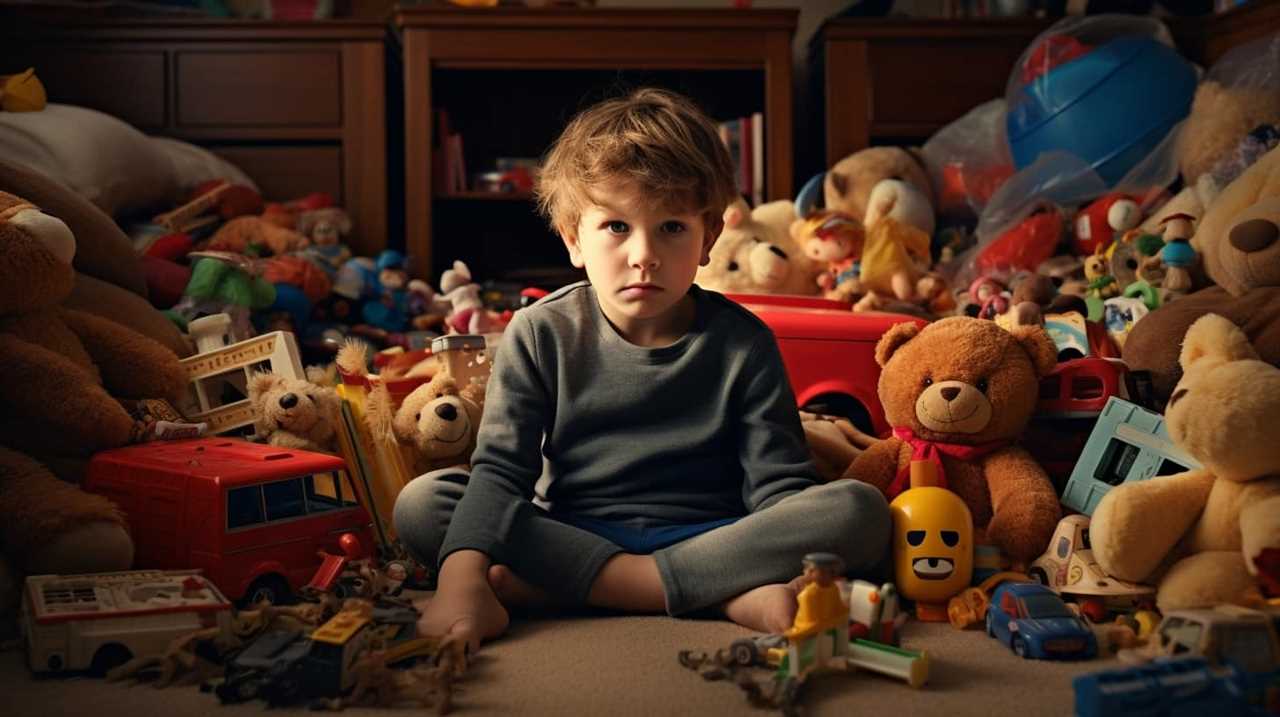
By incorporating these visual sensory toys into a child’s playtime, we can provide them with meaningful opportunities to enhance their visual perception skills and support their overall development. Let’s take a look at some examples in the table below:
| Sensory Puzzle | Visual Tracking Activity |
|---|---|
| Shape Sorter | Light-Up Spinning Toy |
| Tangram Puzzle | Rolling Ball Maze |
| Jigsaw Puzzle | Bubble Tube |
| Magnetic Building Blocks | Fiber Optic Light Wand |
Sensory Bean Bags
We find sensory bean bags to be a versatile and engaging tool for promoting sensory exploration and development in preschoolers with autism. Here are three reasons why sensory bean bags are beneficial:
-
Sensory bean bag games: Sensory bean bags can be used in various games that stimulate different senses. For example, children can play a game where they toss the bean bags onto different textures, such as soft pillows or rough surfaces, to enhance their tactile perception.
-
DIY sensory bean bags: Making your own sensory bean bags can be a fun and cost-effective activity. You can fill them with different materials, such as rice, beans, or textured fabric, to provide a variety of sensory experiences. This allows you to customize the bean bags based on the specific needs and preferences of the child.
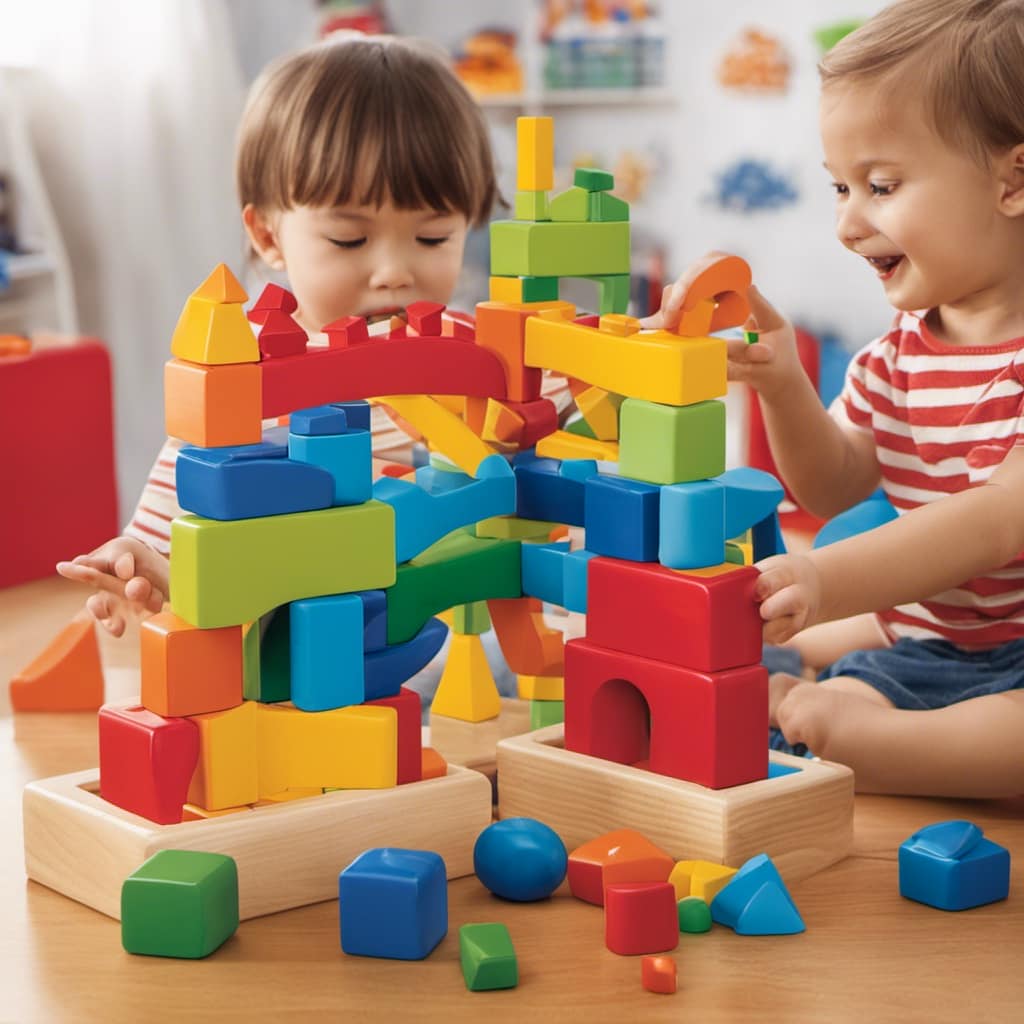
-
Sensory input and regulation: Squeezing, tossing, and manipulating sensory bean bags can provide proprioceptive input, which helps children with autism regulate their sensory systems. This can have a calming effect and promote focus and attention.
Sensory Water Tables
One of the most popular sensory toys for autism in preschool is the sensory water table.
Sensory water tables provide a wide range of therapeutic benefits for children with autism. The sensory experience of playing with water can help stimulate their senses and promote sensory integration.
The different textures and temperatures of the water can provide a calming and soothing effect, helping to reduce anxiety and stress.
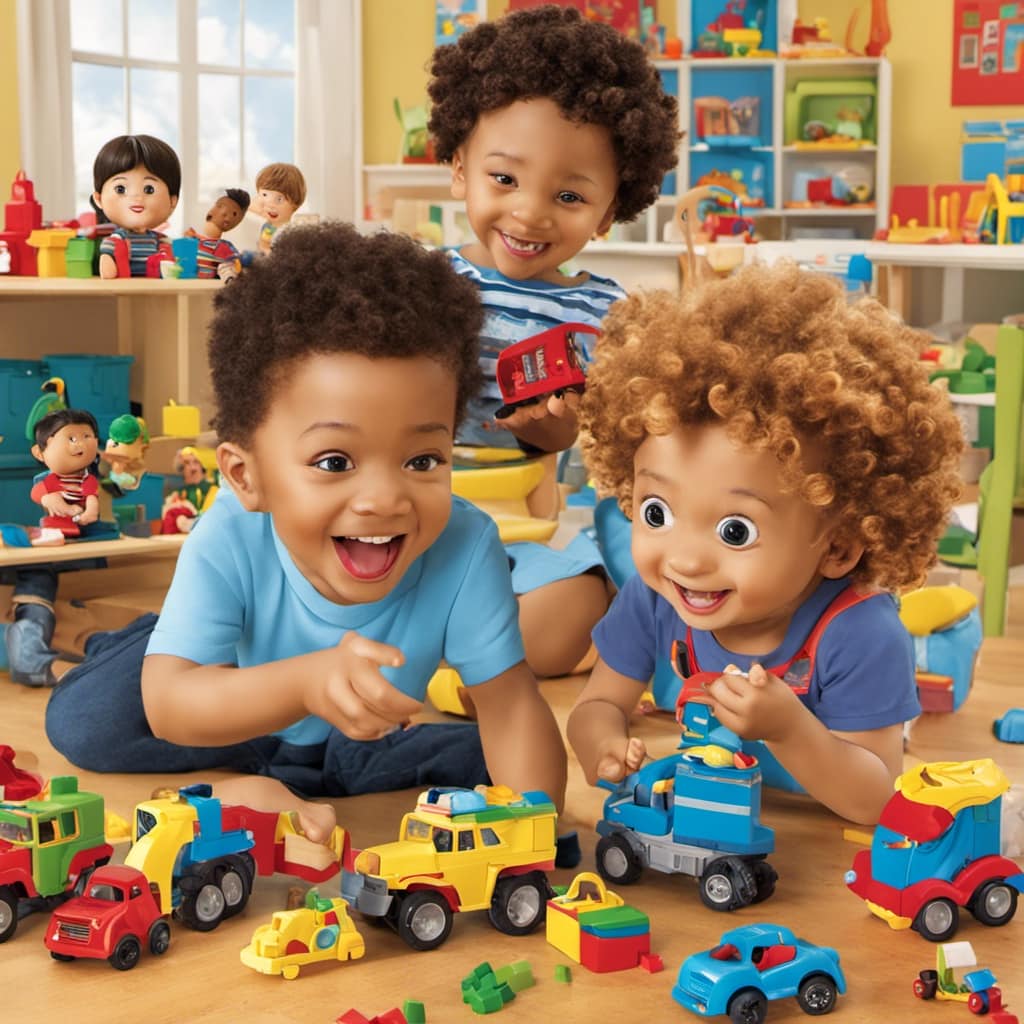
Water tables also offer opportunities for social interaction and communication, as children can play together and engage in cooperative play.
Additionally, water play can improve fine motor skills as children scoop, pour, and manipulate the water.
Overall, sensory water tables are an effective tool for developing sensory processing skills and promoting overall development in children with autism.
Moving on to our next topic, let’s explore the therapeutic benefits of sensory swing sets.

Sensory Swing Sets
Moving on from sensory water tables, another popular sensory toy for autism in preschool is the sensory swing set. It offers a variety of therapeutic benefits for children with autism.
Sensory swing therapy is a great way to provide deep pressure input, vestibular stimulation, and proprioceptive feedback. All of these can help regulate sensory processing and improve focus and attention.
The gentle swinging motion of the sensory swing set can promote relaxation, reduce anxiety, and enhance body awareness. It can also improve balance and coordination skills, as children learn to control their body movements while swinging.
The sensory swing benefits extend beyond the physical realm. They can also provide a calming and soothing environment for children with autism, allowing them to feel safe and secure.
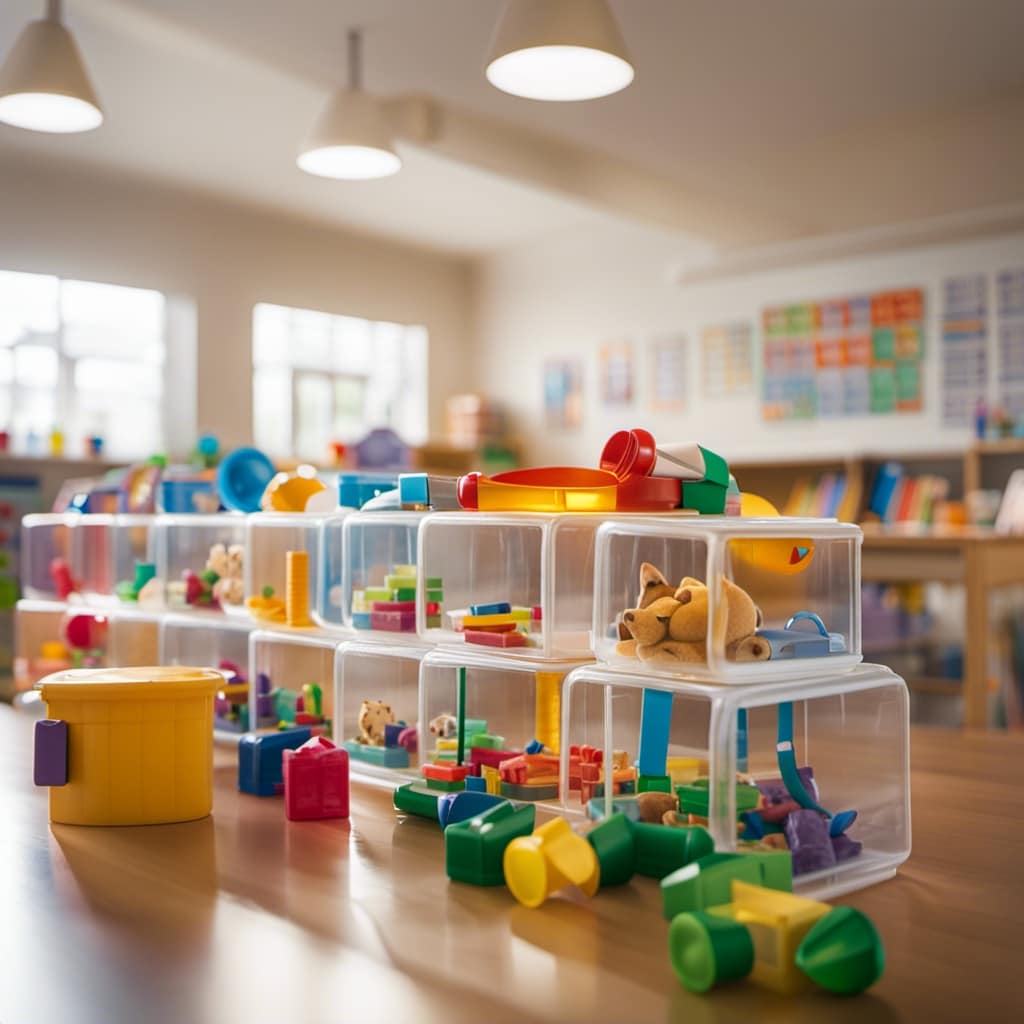
Sensory Building Blocks
Continuing our exploration of sensory toys for autism in preschool, let’s now delve into the benefits of sensory building blocks.
Sensory building blocks aren’t only fun to play with, but they also provide a multitude of benefits for children on the autism spectrum. These blocks help develop fine motor skills, hand-eye coordination, and spatial awareness. They also stimulate the senses through their different shapes, textures, and colors, promoting sensory exploration.
Sensory puzzles are a great addition to building blocks, as they engage children’s problem-solving skills and cognitive development. Additionally, incorporating sensory music into playtime can enhance auditory processing and promote relaxation.
Frequently Asked Questions
How Do Fidget Spinners Help Children With Autism in Preschool?
Fidget spinners are sensory toys that can help children with autism in preschool. They provide a calming effect, improve focus, and promote fine motor skills development. We’ve seen great results using them in our classroom.

What Are the Benefits of Using Weighted Blankets for Sensory Stimulation in Preschoolers With Autism?
Using weighted blankets for sensory stimulation in preschoolers with autism can provide a sense of calm and security. They can help regulate sensory input and promote relaxation, similar to weighted vests and sensory swings.
How Do Sensory Balls Assist in the Development of Sensory Skills in Children With Autism in Preschool?
Sensory balls are essential for sensory development in preschoolers with autism. They promote sensory skills through sensory play, aiding in sensory integration and improving motor coordination.
What Is Chewelry and How Does It Contribute to Sensory Integration in Preschoolers With Autism?
Chewelry is a type of oral sensory toy that provides benefits for preschoolers with autism. It helps with oral stimulation, which is important for sensory integration in children with autism.
What Are Sensory Bottles and How Can They Be Used to Engage Children With Autism in Preschool?
Sensory bottles are engaging tools that can be used in preschool to stimulate children with autism. They provide visual and tactile sensory experiences, promoting focus and exploration. Sensory bins are also beneficial for sensory integration.

Conclusion
In conclusion, sensory toys are essential for preschoolers with autism as they provide a range of benefits.
From fidget spinners to weighted blankets, sensory toys help in creating a calming environment and improving focus. They also enhance sensory development and provide a soothing sensory experience.
By incorporating these toys into their daily routines, parents and educators can support the sensory needs of children with autism and help them thrive in their preschool years.
Mila, a gifted writer with a heart brimming with enthusiasm for child development and playful learning, is the creative force behind the enchanting narratives and insightful articles that grace Toddler Ride On Toys. With a background in early childhood education and a genuine passion for nurturing young minds, Mila weaves words that captivate, educate, and inspire parents, caregivers, and educators.

